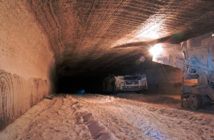ProActive Investors USA & Canada

Three of today’s main stories by Proactive Investors were dedicated to
the oil and gas sector.
One of the reports covered a note from Credit Suisse, which said the
resumption of oil exports by the Kurdistan Regional Government is
likely to provide only “short-term respite” to the current supply
problems in Iraq.
Last week the semi-autonomous region of Iraq said it would resume oil
exports at a rate of 100,000 barrels a day.
However, the fraught and politically complex relationship between
north and south meant this wasn’t a straightforward offer to turn the
taps back on.
The Kurdistan Regional Government has threatened to resume the embargo
at the end of the month unless it receives an estimated US$1.5 billion
in oil payments it says are being withheld by the Iraqis.
“What I have in mind is to restart the oil export for only one month,
i.e. for all of the August period,” said the KRG’s Natural Resources
Minister Ashti Hawrami in a letter written at the end of last month.
“If the payments are not released by the end of this period, then we
agree to halt all the export at the midnight of 31st August.”
The source of the friction is the KRG’s decision to unilaterally award
new oil licences to foreign companies in northern Iraqi region.
In the note, Credit Suisse analyst Thomas Adolff predicted the lifting
of the embargo will be temporary.
“This is likely to be a short-term respite, and we see the chances of
continued exports (ex trucking) from Iraqi Kurdistan as relatively low
after August in the absence of its own export pipeline (only targeted
for completion in late 2013),” he said.
A permanent resolution to the dispute between Erbil and Baghdad would
have very positive implications for companies operating in Kurdistan –
none more so than Gulf Keystone Petroleum (LON:GKP).
Its main asset is a majority stake in the super-giant Shaikan Field,
which contains 12.4 billion barrels of oil estimated on a P90 basis
(denoting a 90 per cent certainty of being produced).
It also has interests in the Sheikh Adi, Ber Bahr and Akri-Bijeel
blocks as well as producing oil for the domestic market from Shaikan.
And it is one of a number of ambitious mid-ranked explorers making its
name by opening up one of the last few remaining new oil frontiers.
GKP and Genel (LON:GENL), headed by former BP chief executive Tony
Hayward, were first movers, followed Petroceltic (LON:PCI) and Afren
(LON:AF).
Another broker note said that a huge re-rating of Pura Vida (ASX:PVD)
is inevitable.
Hartleys analyst Dave Wall notes other companies with Moroccan acreage
of a similar size and quality to PVD’s are valued in excess of US$200
million versus PVD’s current US$12 million market value.
“The value proposition is extremely compelling,” he said in a note to
clients, in which he set a 113 cents price target for the shares
(versus the current price of 30 cents).
Pura Vida’s strong acreage position offshore Morocco, a hot
exploration post code this year, is the reason for the broker’s
bullish view.
Indeed, he says the firm’s early move to secure a 75 per cent interest
in the Mazagan permit, spanning 10,900 square kilometres, was an
excellent deal.
The company has reprocessed and has mostly re-interpreted existing
seismic data – covering 3,570 square kilometres – which has allowed it
to book potential recoverable resources of 2.4 billion barrels of oil.
It is currently re-interpreting the remainder of the data and,
according to Wall, a farm-out process could occur as early as October.
He says this would allow drilling to get underway late next year or
early 2014.
Large US oil firm Kosmos Energy is planning to drill three wells in
neighbouring acreage next year, and last month’s reported entry of
London-listed Genel also highlights the increasing industry interest
in Morocco.
The presence of Kosmos nearby is particularly significant. As the
discoverer of the large Jubilee field offshore Ghana, it has been
targeting new areas where it expects to find similar geology – formed
millions of years ago before the world’s continents are beleived to
have separated.
Similarly, fellow Jubliee partner Tullow has made a ‘related’
discovery in South America, the Zaedyus field offshore French Guina,
using this ‘continental drift theory’. Other comparisons are made
between potential discoveries in Morocco and Canada’s east coast.
And it is in considering these apparently corresponding prospect that
Hartleys derives its comparison to US$200 million peers.
We also covered today’s news fomr Providence Resources (LON:PVR).
The oil and gas group has mapped another potentially significant oil
target offshore Ireland.
The Barryroe project, which is set to become Ireland’s first
commercial oil field, has been the focal point and a source of
excitement in recent months but it is just one of several projects the
company is pursuing.
It already has five more targets slated for drilling in the current
campaign over the next eighteen months. Today, it highlighted the
Drombeg prospect, offshore Cork, as an additional target that is
nearing ‘drill ready’ status.
Drombeg is in the southern Porcupine basin around 60 kilometres away
from the Dunquin exploration prospect, which will be drilled in
partnership with ExxonMobile next year.
And third party analysis, carried out by contractor Ikon Science,
suggests it could span an area of 240 square kilometres, with
hydrocarbon bearing sandstone reservoirs having thicknesses of 200-300
feet.
Ikon also believes there is a large Jurassic feature existing beneath
the prospect.
Providence owns an 80 per cent stake in the project and it says it
will now seek partners for a drill programme to test Drombeg.
“Given Drombeg’s location and water depth, it is likely that we will
seek a capable joint-venture partner with deepwater operating
experience though that view may change with positive results from the
upcoming Dunquin well,” said John O’Sullivan, technical director.
“We hope to be in a position to update the market on the prospective
oil and gas resource potential of Drombeg during Q4 2012.”
Away from oil and gas, the banking sector was hit by another scandal today.
Standard Chartered (LON:STAN) had £8.4 billion wiped off its market
value after shares tumbled almost 24 per cent on threats by New York
state regulators to revoke its licence for illegal dealings with Iran.
Brokers across the board today lowered their sights on the stock,
noting the potential reputational damage of allegations the bank
conspired with the Iranian government to hide US$250 bln worth of
transactions.
Some suggested the Asia-focused bank could lose its clearing licence
for US dollars, in effect wiping as much as 40 per cent off the
group’s earnings.
Others, such as Nomura, which was one of the City firms along with
Canaccord Genuity and Oriel Securities to downgrade the stock, said
this was not a likely outcome.
“It’s difficult to think that the bank could lose its licence, but you
can’t rule it out,” said Nomura analyst Chintan Joshi.
Analysts previously had Asian banks StanChart and HSBC
(LON:HSBA)marked down as their preferred picks over British lenders.
The London-based bank vehemently denied allegations, stating that
“99.9 per cent of the transactions relating to Iran complied with the
regulations” and those that did totalled just US$14 mln.
The rebuttal followed a sharp sell-off of Standard Chartered shares in
Asia overnight after the New York State Department of Financial
Services (DFS) issued a 27-page order against the bank.
The DFS alleged that between 2001 and 2010, Standard Chartered’s US
unit operated as a “rogue institution” allowing billions of dollars of
money from Iranian institutions to flow through it.
The head of the DFS, Benjamin Lawsky, has called for the bank to
appear before a hearing on August 15 to justify why its licence should
not be taken away.
In the mining sector, Mariana Resources (LON:MARL, TSE:MRY) said this
morning re-sampling of an earlier batch of drill holes from Calandria
Sur deposit in Argentina had found low grade gold and silver in the
rocks outside and below the main rhyolite dome.
The dome is host to the 441,000-ounce indicated and inferred gold resource.
However, today’s results and those earlier this year when the company
first re-examined the rock around the dome have altered the
understanding of Calandria Sur.
A total of 26 holes from this second batch of 33 previously drilled
holes contained gold and silver, which is described as “disseminated
and veinlet/stockwork” in style.
The best intersections from rock on the eastern border of the main
resource included 11 metres at 0.5 grams per tonne and 5 grams of
silver and 24.5 metres at 0.8 grams of gold and 12 grams of silver.
Below the deposit, Mariana uncovered a 9.5 metre section at 1.2 grams
per tonne of gold and 19 grams of silver and 27 metres at 1.2 grams
per tonne and 13 grams of silver.
Crucially indications from LeachWell assays indicate high gold
recoveries from the country rock hosted precious metal compared with
the dome hosted mineralisation.
Chairman John Horsburgh said: “Re-sampling results will be evaluated
in conjunction with the forthcoming results of the recent drilling
with the potential for a revised resource statement early 2013, if
results are positive.”
.






